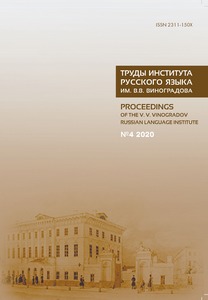THE STRESS IN VERBS ENDING BY “-ИТЬ”: UNFOLDING CHANGES
Abstract:
The question of the stress on “-it” in verb endings remains relevant to date. Starting from the XVIII century there has been a steady change in the choice of accentological variant in these words: an unfixed stress in the verb ending replaces the fixed one. To study the issue, in 2015 and 2024 sociolinguistic experiments focused on 100 verbs with “-it” ending in which authoritative dictionaries noted either normative pronunciation variants or frequency deviations. 120 respondents participated in these experiments: 60 respon dents in 2015 and 60 respondents in 2024. The respondents fell into three age groups: “junior” — up to 25 years old, “middle” — from 26 to 55 years old and “senior” — from 56 years old. A comparative analysis of the data obtained with the difference of 9 years shows: the choice of accentological variant by the majority of respondents in 86 out of 100 verbs with “-it” ending remained unchanged but 14 out of 100 verbs underwent changes: in three cases a movable stress became predominant, six cases showed approxi mately equally distributed results (with an increase in the proportion of fixed stress end ings in relation to the 2015 experiment), in five words a significant part of the respondents started opting for the ending variant with fixed stress. The results show that the process of replacing a fixed stress with an unfixed one despite its productivity is uneven and not instant. Further study of the issue and monitoring of ongoing changes are necessary to reduce the gap between the common usage and codified norms and consequently to over come the existing discrepancy in the pronouncing recommendations presented in various authoritative orthoepical dictionaries.


